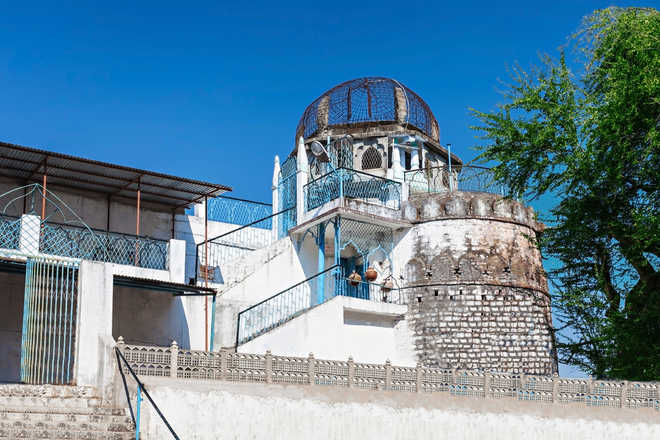Preeti Verma Lal
In a city dotted with innumerable mosques, no one gave this mosque a fancy name. It is simply known as Dhai Seedhi Ki Masjid. Two and a half steps. In Bhopal, this is all that the devout have to climb to reach the prayer hall, kneel and pay obeisance to the lord. The prayer hall is neither ornate nor sprawling. It barely measures four human steps from one corner to another. Built on the turrets of Fatehgarh Fort for the guards to offer namaz, it is Bhopal’s first and Asia’s smallest mosque. In a geographical irony, Asia’s smallest mosque sits in the shadow of Taj-ul-Masjid, India’s largest mosque and one of the largest in the continent. Built by Nawab Shah Jehan Begum of Bhopal in a typical Mughal style of architecture, it has two 18-storey high octagonal minarets and three gigantic bulbous domes that scrape the blue sky. The facade is pink, the pillars stout and the ceilings embellished with petal motifs.
The smallest and the largest mosques are not the only architectural delights of Bhopal, the only princely state that was ruled by four begums for 157 years. There’s Jama Masjid, built by Qudisiya Begum, the first female ruler of Bhopal, and Moti Masjid, which was built in 1860 by Begum Sikander Jehan.
The begums of Bhopal not only spent on mosques, they also built enormous palaces. In Jehan Numa Palace, the white walls narrate the story of Nawab Jehan Begum, the 12th ruler of Bhopal (1901-1926), who gave the city its waterworks, compulsory primary education and built the palace at Shamla Hill. Combining British Colonial, Italian Renaissance and Classical Greek style, the Jehan Numa Palace bears testimony to the legacy of the begums and myriad architectural influences that found home in Bhopal.
Gohar Mahal, named after Qudsiya Begum, is a perfect amalgamation of Hindu and Mughal architecture. The 180-year-old Shaukat Mahal has very distinctive Indo-French design with unique church-like inputs in the interiors and a crown on the facade. The mahal’s design is attributed to Bourbons of Bhopal — considered descendants of French kings.
Taj Mahal, however, was the jewel in the crown. Not the famous mausoleum in Agra but the royal residence of Nawab Shah Jahan Begum. Spread over 120 rooms, a Sheesh Mahal (glass house) and saawan-bhadon pavilion, an elaborate fountain-like structure that simulated the effect of rain, this Taj Mahal was built over 13 years (1871-1884) at a cost of Rs 30 lakh. The mahal combines British, French, Mughal, Arabic and Indian architectural influences and was one of the world’s largest palaces. Sadly, the mahal is crumbling, its walls are moss-laden and its doors have withered away by the vagaries of nature. The Indo-Sarcenic palace, which once reverberated with music and the onomatopoeic sounds of the horse’s hooves, has been declared ‘unsafe’.
Around Bhopal, there are no statues of the begums who lent Bhopal its glory, but in Jehan Numa Palace, there stands Nawab Jehan Begum, painted in oil with valour in her stance and fortitude in her mien. It is in the sparkle of her eyes that the history of Bhopal is told. And retold.
Unlock Exclusive Insights with The Tribune Premium
Take your experience further with Premium access.
Thought-provoking Opinions, Expert Analysis, In-depth Insights and other Member Only Benefits
Already a Member? Sign In Now










